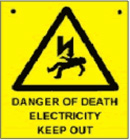Working Safely With Electricity
When planning to work with electricity:
- Do a risk assessment for the work you are planning, and make sure this covers electrical hazards.
- Learn how to recognize electrical wires. These may be overhead power lines, electrical wiring in a workplace, or cables buried under the ground.
- Get an up-to-date map of the services in the area and use it.
- Look for electrical wires, cables or equipment near where you are going to work and check for signs warning of dangers from electricity, or any other hazard. Remember to look up, down, and around you.
- If you will be digging or disturbing the earth or cutting into surfaces, use a cable locator to find buried services and permanently mark the position of services you do find.
- Work away from electrical wiring wherever possible. If you have to work near electrical wiring or equipment, ask for the electrical supply to be turned off. Make sure the power is off, and cannot be turned on again without you agreeing.
- If the electrical supply cannot be turned off, consult a competent person who should be able to advise you on the best way to proceed.
- Identify where it is safe to work. Put up danger notices where there are still live electrical circuits, and warn your co-workers where it is safe to work and where it is not safe. Remember to remove notices at the end of the work.
Information
The booklet ‘Electricity at work, safe working practices’ provides general guidance on working near electricity. Many electricity supply companies will provide advice on how to work safely near electrical distribution equipment. You should contact them directly.
Electrical danger signs

Signs warning of electrical danger may not always be easy to see, or may have been removed, so even if you see no signs, electrical cables may still be nearby. Stay vigilant.
When you see signs warning of electrical danger it is highly likely there is electricity present. Remember, you don’t need to touch a high voltage cable to get an electric shock and even low voltage cables can be dangerous.
If you cannot work out where the electricity is, ask a competent person to do it for you.
The Department for Business, Innovation and Skills (BIS) enforces the use of electrical safety signs on electrical distribution equipment such as substations and electricity poles.

Electrical Wiring
You may not see electrical wires near where you plan to work but this doesn’t mean there aren’t any. Even if you do see wires, there may be others you cannot see. Electrical wiring may sometimes look like pipes, and may be a range of colours.
Before you drill or start cutting into surfaces:
- look for electrical wires and any other hazards such as asbestos. Remember to look on both sides of walls;
- ask to see plans of the electrical installation, and use these to find electrical wiring;
- If you are competent, use a suitable cable detector, or get a competent person to do it for you. Remember that some cable detectors won’t find a wire carrying a small current – consult the user guide.
- look for nearby electrical equipment or installations and find where the wiring runs to these.
- use equipment that will minimize the risks during the work.
- wear suitable protective clothing.
If you are in doubt STOP WORK and consult a competent person. Look for electrical wires and any other hazards such as asbestos.
The standard for wiring colours has recently changed. The information leaflet describes the new colour scheme.
Cable Colours
Many electrical cables are coloured to show their purpose and the voltage they are carrying. However, there are many standards used around the world, and you should never assume that a cable of a particular colour is at a particular voltage. An information leaflet gives details of recent changes to the colour code . It is very important that you identify what voltages are present on an installation you are not familiar with.
Making sure the power is off
If you are not competent to check if the power is off, ask a competent person to do it for you, and watch them doing it. If you have any doubts about the method they have used, ask someone you know is competent.
When checking that power is off the competent person should be SURE that:
- The device being used is suitable for the purpose of isolation.
- The isolator being used to turn off the power is working correctly and reliably.
- The switch being used is the only way that the circuit can be fed with electrical power.
- The switch being used is locked in the off position and cannot easily be turned on again.
- The equipment and method being used to check for voltage works and is reliable.
- The isolation has been successful by confirming the circuit is no longer ‘live’.
Some electrical systems and equipment must be earthed before it is safe to work near them. Check whether this is necessary, and if it is, ensure that this is done properly.
Making sure the power stays off (Secure Isolation)
If the electrical power has been turned off to allow you to do work safely, it is essential that the power stays off until you have finished work. Make sure YOU are in control and STAY in control. A good way is to have the only key to the switch or a locked room or cabinet containing the switch. Remember, if you remove a fuse, another one could be inserted in its place, and people ignore notices. If you have any doubts that the electricity may be turned on again without you agreeing, STOP WORK.
*(courtesy of HSE: http://www.hse.gov.uk/electricity/nearelectric.htm)

